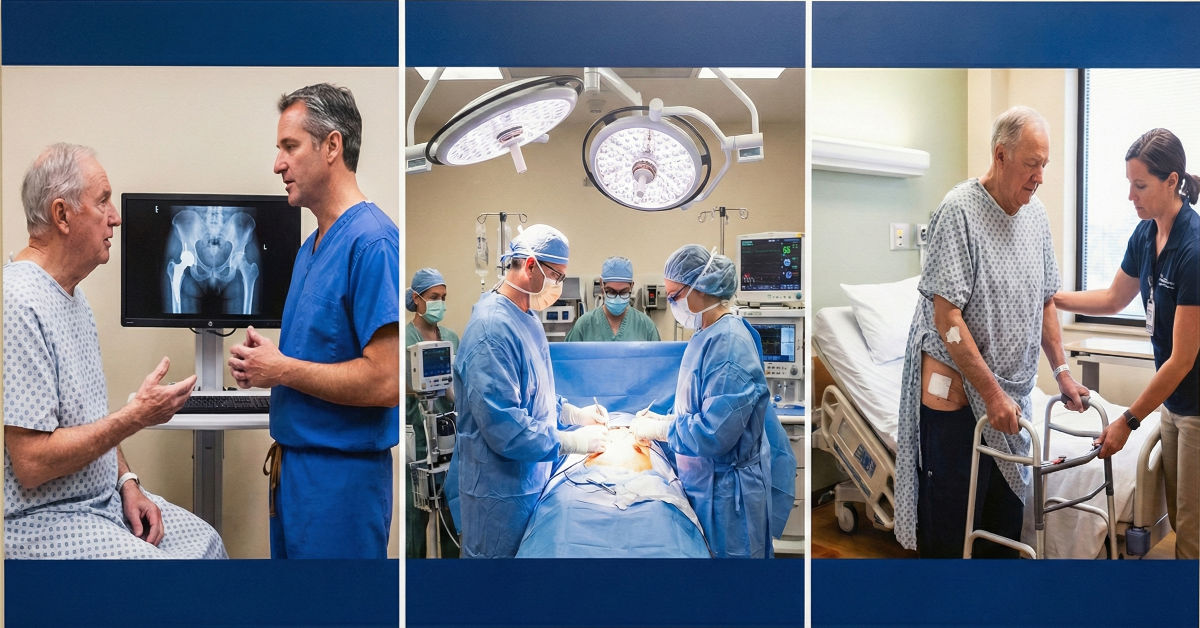Hip replacement surgery has become one of the most successful and transformative
orthopedic procedures in modern medicine. For patients suffering from chronic hip pain, stiffness, or reduced mobility caused by arthritis, fractures, or joint deterioration, this surgery offers the promise of walking again without pain and regaining a better quality of life.
Whether you are planning your procedure locally or abroad, understanding what happens before, during, and after hip replacement surgery can help you prepare confidently and recover efficiently.
Before the procedure: Preparing for surgery
Preparation is crucial for a successful hip replacement. Before surgery, the orthopedic surgeon performs a full medical assessment, including imaging, to evaluate joint damage. Medical history, current medications, and chronic conditions are reviewed, and lifestyle adjustments, like quitting smoking or doing pre-surgery physiotherapy, may be recommended.
Light exercises to strengthen the upper body are often suggested to help with crutches or walkers post-surgery. Preparing your home by creating a safe, comfortable space and arranging support for daily activities also helps ensure smoother recovery.
During the Procedure: What happens in the operatingroom
Hip replacement, or total hip arthroplasty, replaces damaged joint parts with metal, ceramic, or plastic implants. The surgery, under general or spinal anesthesia, typically lasts 1–2 hours. The surgeon removes damaged bone and cartilage, reshapes the hip socket, and fits a prosthetic stem and ball for smooth, pain-free movement.
Modern techniques like minimally invasive surgery, computer-assisted navigation, and robotic assistance, used by the best hip replacement doctors in Turkey, improve precision, shorten recovery, and ensure long-term success, making hip replacement a highly reliable orthopedic procedure.
After the procedure: Recovery and rehabilitation
Recovery from hip replacement surgery starts immediately after the operation. Most patients stay in the hospital for a few days, during which physical therapists guide them through safe movements and exercises to prevent stiffness and blood clots.
| Phase | Timeframe | Key Goals | Recommended Activities |
| Hospital Stay | Days 1–4 | Pain control, start gentle movement | Physiotherapy sessions, sitting up, assisted walking |
| Early Recovery | Weeks 1–4 | Increase mobility, avoid joint strain | Walking with support, light home exercises |
| Mid Recovery | Weeks 4–8 | Strength and flexibility training | Independent walking, stair practice, mild stretching |
| Late Recovery | Months 2–3 | Regain full independence | Driving short distances, light daily tasks |
| Full Recovery | After 3–6 months | Return to active lifestyle | Swimming, cycling, low-impact sports |
By the fourth to sixth week, most patients can walk independently and perform light activities. Full recovery can take three to six months, depending on age, physical condition, and dedication to rehabilitation.
It’s also crucial to follow your surgeon’s advice about avoiding certain movements, like crossing your legs or bending too far, to prevent dislocation. Physiotherapy remains the cornerstone of recovery: strengthening surrounding muscles ensures stability and protects the new joint for years to come.
Potential risks and how to minimizethem
Although hip replacement surgery has a high success rate, it carries some potential risks like any major procedure. These may include infection, blood clots, joint dislocation, leg length differences, or implant wear over time.
Choosing an experienced surgeon, maintaining good hygiene, and following post-operative instructions carefully can drastically reduce these risks. In recent years, advancements in surgical materials and antibiotic protocols have made complications increasingly rare.
Choosing the rightclinic and destination
Turkey has become a trusted hub for orthopedic care, offering modern hospitals, internationally accredited facilities, and highly skilled specialists performing thousands of joint replacements annually. Patients benefit from high-quality care at more affordable prices, with full-service support including pre-surgery consultation, rehabilitation, and travel coordination.
This combination of expertise, affordability, and comfort makes Turkey one of the top choices for medical treatment in Turkey, attracting patients from Europe, the Middle East, and beyond.
Life afterhipreplacement
A successful hip replacement can be life-changing. Once fully recovered, most patients can walk, climb stairs, and even return to sports such as swimming, golf, or cycling. The goal is not just to eliminate pain but to restore independence and mobility, allowing people to live more actively and confidently.
Many patients report a dramatic improvement in their emotional well-being after surgery, as the ability to move freely without pain significantly enhances quality of life. Regular follow-up appointments, healthy lifestyle habits, and staying physically active will help protect the new joint for years to come.
Conclusion
Hip replacement surgery is a proven, effective solution for those suffering from chronic hip pain or joint deterioration. Knowing what to expect before, during, and after the procedure helps reduce anxiety and promotes a smoother recovery.







